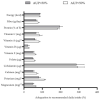The Importance of an Early Evaluation after Establishing a Gluten-Free Diet in Children with Celiac Disease
- PMID: 37049601
- PMCID: PMC10097184
- DOI: 10.3390/nu15071761
The Importance of an Early Evaluation after Establishing a Gluten-Free Diet in Children with Celiac Disease
Abstract
A gluten-free diet (GFD) is the only treatment available for celiac disease (CD); hence, it is important to ensure correct adherence to the diet and adequate monitoring of the diet. The present study aims to assess the importance of an early follow-up of celiac patients after diagnosis of the disease, identify the role of stool gluten immunogenic peptides (GIPs) in the assessment of GFD adherence, and analyze possible nutritional imbalances or deficiencies in the GFD. This is a cross-sectional study carried out in pediatric patients with newly diagnosed CD in a tertiary hospital in Spain. Of the 61 patients included, 14% had positive stool GIPS at 4 months after CD diagnosis, Among them, 88% had negative stool GIPS at 9 months after diagnosis, following dietary advice. We found nutritional deficiencies in the GFD, such as vitamin D (with only 27% of patients with adequate intakes), folate, calcium, magnesium, and fiber. Similarly, we found imbalances: excess protein and fat intakes and a high percentage of total daily energy intake came from ultra-processed foods (UPF). These findings emphasize the importance of early follow-up of children after diagnosis of CD. It is also crucial to identify patients with poor GFD compliance based on stool GIPS and analyze GFD nutritional imbalances and deficits. Our findings may contribute to the development of specific strategies for the early follow-up of patients with CD, including appropriate nutritional counselling.
Keywords: celiac disease; gluten immunogenic peptides; gluten-free diet; ultra-processed foods.
Conflict of interest statement
The authors declare no conflict of interest. The funders had no role in the design of the study; in the collection, analyses, or interpretation of data; in the writing of the manuscript, or in the decision to publish the results.
Figures





Similar articles
-
Nutritional Deficiencies in Children with Celiac Disease Resulting from a Gluten-Free Diet: A Systematic Review.Nutrients. 2019 Jul 13;11(7):1588. doi: 10.3390/nu11071588. Nutrients. 2019. PMID: 31337023 Free PMC article.
-
Gluten Immunogenic Peptides Are Not Correlated With Reported Adherence to Gluten-Free Diet in Children With Celiac Disease.J Pediatr Gastroenterol Nutr. 2023 Aug 1;77(2):244-248. doi: 10.1097/MPG.0000000000003835. Epub 2023 May 19. J Pediatr Gastroenterol Nutr. 2023. PMID: 37204826
-
Comparison of weekly gluten immunogenic peptide measurement and conventional tools to assess adherence to the gluten-free diet in celiac disease: An observational prospective study.Am J Clin Nutr. 2023 Dec;118(6):1106-1112. doi: 10.1016/j.ajcnut.2023.10.001. Epub 2023 Oct 6. Am J Clin Nutr. 2023. PMID: 37806557
-
Micronutrient deficiencies are frequent in adult patients with and without celiac disease on a gluten-free diet, regardless of duration and adherence to the diet.Nutrition. 2022 Nov-Dec;103-104:111809. doi: 10.1016/j.nut.2022.111809. Epub 2022 Jul 30. Nutrition. 2022. PMID: 36096056
-
Celiac disease: understanding the gluten-free diet.Eur J Nutr. 2017 Mar;56(2):449-459. doi: 10.1007/s00394-016-1238-5. Epub 2016 Jun 22. Eur J Nutr. 2017. PMID: 27334430 Review.
Cited by
-
Importance of an Ongoing Nutritional Counselling Intervention on Eating Habits of Newly Diagnosed Children with Celiac Disease.Nutrients. 2024 Jul 25;16(15):2418. doi: 10.3390/nu16152418. Nutrients. 2024. PMID: 39125299 Free PMC article.
-
Effect of Gluten-Free Diet on Metabolic Control and Growth Parameters Among Children and Adolescents With Type 1 Diabetes During the First Year After Diagnosis of Celiac Disease: A Retrospective Case-Control Study.Pediatr Diabetes. 2025 Jul 4;2025:1283259. doi: 10.1155/pedi/1283259. eCollection 2025. Pediatr Diabetes. 2025. PMID: 40655315 Free PMC article.
References
-
- Ruiz-Carnicer A., Garzon-Benavides M., Fombuena B., Segura V., Garcia-Fernandez F., Sobrino-Rodriguez S., Gomez-Izquierdo L., Montes-Cano M.A., Rodriguez-Herrera A., Millan R., et al. Negative Predictive Value of the Repeated Absence of Gluten Immunogenic Peptides in the Urisne of Treated Celiac Patients in Predicting Mucosal Healing: New Proposals for Follow-up in Celiac Disease. Am. J. Clin. Nutr. 2020;112:1240–1251. doi: 10.1093/ajcn/nqaa188. - DOI - PubMed
-
- King J.A., Jeong J., Underwood F.E., Quan J., Panaccione N., Windsor J.W., Coward S., Debruyn J., Ronksley P.E., Shaheen A.A., et al. Incidence of Celiac Disease Is Increasing Over Time: A Systematic Review and Meta-Analysis. Am. J. Gastroenterol. 2020;115:507–525. doi: 10.14309/ajg.0000000000000523. - DOI - PubMed
MeSH terms
Substances
Grants and funding
- Project No B-AGR-658/FEDER/Junta de Andalucía-Consejería de Transformación Económica, Industria, Conocimiento y Universidades/ Project No B-AGR-658
- Investigation grant program by the Association of Celiacs and Sensitive to Gluten of the Com-munity of Madrid
- FPU17/03715/Spanish Ministry of Education, Culture, and Sports
- BIOMEDAL S.L.
LinkOut - more resources
Full Text Sources
Medical

